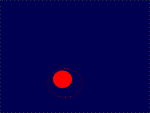
-- A Cyberspace Review Of The Arts
Volume 18.05
August 8, 2011
 Ryan Trecartin's 'Any Ever' at MoMA/PS1I have now done four tours through Ryan Trecartin's Any Ever installation at PS1, and just as you should have gone to the Alexander McQueen show, so you should go to this one, although it's a lot easier to get into, being in down-home-yet-hip Long Island City rather than the Met. (It is not likely to be as crowded as McQueen because as you know tourists are afraid to cross the water. I don't know how they get to Manhattan!)
Many of the reviewers of this work (see the list of URLs below) opine that the installation is a kind of avant-garde adventure into new territory, but I see it rather as a magisterial summing-up of recent, in a sense 'established' avant practices about current social and political concerns — one might almost say a tradition, which began only a few decades ago as artists began to experiment with video and the machines which produce it (Nam June Paik being the most famous) and as the Empire began to go into visible decline. This is an area in which innovation can be classicized if not burned up very quickly, sometimes in a few seconds -- for example, some people labored hard and long at their computers to create the image of a spinning cube whose faces were active video screens, and yet once it was shown on television, it was done, and quickly devolved into visual furniture for news programs and advertising and seems to have been subsequently abandoned. Or consider the almost instantaneous banalization of the fast-mo cloudy skies and traffic lights in Koyaanisqatsi, effective when first seen in the movie but now rather drained of both surprise and signification, although still good for borders or small subscreens. Sometimes, however, innovation meets a better fate.
I am not going to make much of an attempt to describe the installation in detail: you hadda be there, or actually, ya gotta go there, since it will be at PS1 until September. You can get a vague idea of the material by looking at the link to the official web site, and there are editions of the videos on Vimeo (again, see below), but the strong environmental experience is an important part of the show. The MoMA/PS1 URLs will also tell you more about the principals who put the show together, Trecartin, Lizzie Fitch (no known relation to your reviewer) and many others.
The installation is divided into eight rooms; there is a sort of foyer or lobby, surrounded by seven other rooms in a topologically circular arrangement, so that one can move through them to the right or left, but can get to one only through another. They make a ring.
Some of the rooms are parodies of rooms in a middle- class suburban dwelling, while others parody an office or workshop. The rooms are generally rather dark, and are generally pervaded by a smoothly subaqueous ambient sound. A movie is running on a large screen in each room; the movies last maybe half an hour and then start over. More about them momentarily. Each room contains a variety of chairs, benches, or other sittable structures, at which headphones are supplied. Everything is somewhat out of proportion or oddly designed. Objects which appear in the movies may be found lying around, a hammer on an Ikea-elegant sideboard, for example, which we will see smashing pictures in the video belonging to that room. (There is a lot of light smashing and trashing of artifacts.)
The headphones give the sound track of the movie in the room, which is almost always very much at variance with the low-key sound of the installation's space, and is inaudible unless one uses the headphones.
The movies, both as to visuals and sound, are very aggressively designed. Both color and sound are strongly hyped, and just about every trick that can be summoned from an advanced video editor is thrown at the viewer, often several at a time, and very rapidly. Overall, the movies imitate or greatly exceed contemporary television in the realm of fast cutting and sharp transitions, and in many, maybe most cases, more than one (more than several!) pictures are being displayed, the subordinate images being presented as subwindows, wallpaper, or ghostly overlays. In one case a character is flashed into text several times! This dazzling video extravaganza is one of the delights of the show.
I should add that almost everything is done with high production values. This is not a fuzzy garage project; the videos have high definition and the sound has considerable range and depth.
The make-up and dress of the actors, who are mostly teens or pre-teens, is very deliberately overdone and often highly improbable, and it is clear that the actors (many of them professional child actors) have been directed to use excessively large gestures and loud and fast speech, as if they were engaged in very broad, highly vigorous parody (as indeed they often are). There is a good deal of random, almost violent physical movement, but in fact the movies are very low on real violence; in fact, there is not even much verbal violence.
What is being parodied varies from movie to movie, but includes popular and corporate culture and especially contemporary television fare like news, soap opera, 'reality' shows and music videos -- and, of course, the jewel in the television lotus, commercials. Besides advertising, work and entertainment roles, there is considerable gender-bending which has of course been a recurrent theme in contemporary mainstream cinema, where it is supposed to excite the masses without offending them too much. There are a few nods toward porn/romance, but except for one passage of one movie (which reminded me of Robert Yarber's dolls falling through a tropical urban twilight ) this major fascination of mainstream culture is handled pretty lightly. Perhaps it is going out of fashion.
The sound is interesting. Much of it treated with extreme processing, including compression, filtering, and frequency alteration, which makes it mostly indecipherable (to me), although isolated words and phrases come through. I believe this effect is intentional. I thought my aged hearing and brain might simply not have been up to the challenge, but some young adult and teenage visitors I asked at the installation site generally had the same perception (or else they were humoring me; those who say don't know, and those who know don't say, etc.) However, it is by no means random or unscripted. The music running along with the voices often supports, comments on, or counterpoints them. This, to me, is not far from the classical recitative although I am sure the intentions of the composer (also Trecartin) were probably not operatically explanatory.
Speaking of language, the videos often include text, typically a single word or short phrase, sometimes flashed on the screen too quickly to read, and sometimes superimposed on other words. These words may echo or contrast with the sound track. This is, of course, one of the earliest conceits of postmodern filmmaking, and thus comports happily with my 'magisterial summing-up' trope, yet is to this day still faintly violative of older cinematic mores except when used humorously to parody silent films. Not here: it's one of the actors. Or more than one.
Each movie might be said to present a theme or a mood in quasi-story form, but, as the literature pasted to the wall or given as handouts advises us (see the material from MoMA press release below) they are non-narrative and non-sequential, although as noted certainly carefully planned. On the other hand, there are many instances of vignettes which recur in the same movie, and items like characters, phrases, gestures, makeup, articles of clothing from one movie sometimes pop up in another, bringing a certain amount of the mood or theme of its source with it — just as persons or events may do in what we humorously call the 'real world'. The fact that much of the material parodies this real world or its representation in the media helps us to locate the scenes, some of them all too familiar, in our own personal narratives.
What we have here, I would say, might be compared to a nightmare visit to the cineplex in the mall which has become mixed in our dream with surreal parodies of our home and work environments. On the screen we see Life with a capital L, not as we actually experience it but as we are told to experience it and as it is constructed for us, but enormously compressed and overclocked, wherein the people we know have been replaced by fast-moving teen-age demons. Just another hard day's night, one might say. It's quite an experience, and you'll never get it out of a book — or from a review.
-- Gordon Fitch }{ Links }{
|
|
|
|
|
|
|
|
|
Gordon Fitch |
|
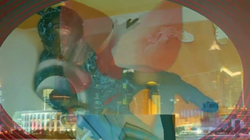



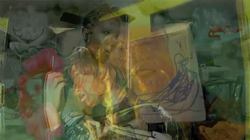


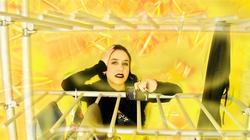



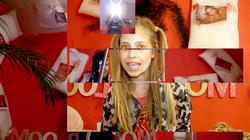


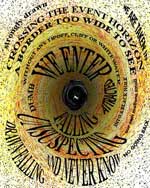
 Back to the Front
Back to the Front